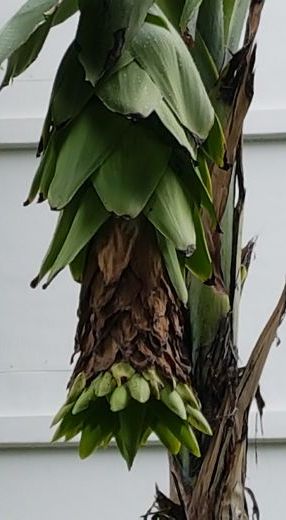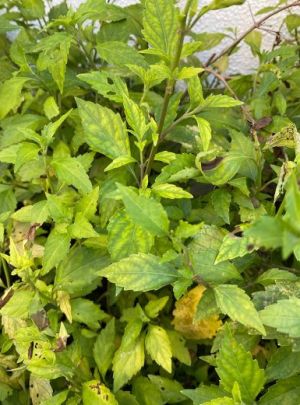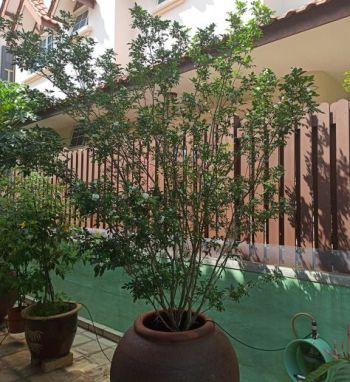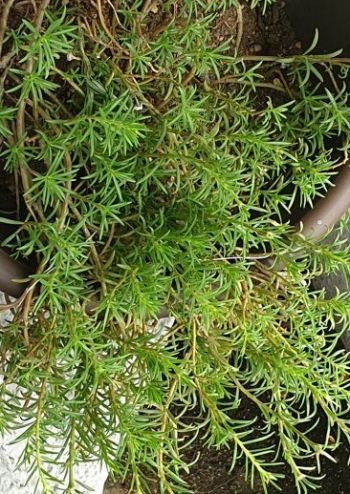Gardening FAQ #10 – What You Need To Know
In this article, we reveal what banana you should avoid, why good drainage is needed, how to check if you have healthy roots and more. Let’s go through the common gardening FAQ, problems and solutions you need when growing your plants indoor and outdoor.
Snow Banana is not edible
 I saw this banana plant with a flower bud in a community garden. What kind of species is it and where does it originate from?
I saw this banana plant with a flower bud in a community garden. What kind of species is it and where does it originate from?
The plant is commonly called the Snow Banana. Its botanical name is Ensete glacum.
It originates from mountainous areas in southern Asia such as Myanmar, Thailand, India and southern China. It can be grown in the tropics in the lowlands where plants do not grow as large.
The fast-growing snow banana is not so well known like many other species. It grows a strong, waxy and green-blue pseudostem. Its long leaves can grow to as much as 2-2,5 metres in size, with the stem able to attain a height of 3-3,5 metres. The plant is growing so fast, it sometimes reaches a height of one metre already after 4 months.
The seeds can be started indoors at any time throughout the year. The very hard seeds should be carefully roughen with sandpaper, be left to soak in water at room temperature for 24 hours and then be pressed 1 cm deep into moist cultivation soil. With temperatures at 22°-25°C, germination follows after 3-6 weeks.
Unlike the dessert and cooking bananas, the fruit of this species is not edible, with large seeds and little flesh.
Cat’s Whiskers need good drainage – a common question in our gardening FAQ
 Over the past few months, the leaves of my Cat’s Whiskers have turned yellow and there are no new leaves. The plants are beginning to bald. Do I have to uproot them?
Over the past few months, the leaves of my Cat’s Whiskers have turned yellow and there are no new leaves. The plants are beginning to bald. Do I have to uproot them?
The new leaves of the plant in the photo are chlorotic in appearance, where the areas between the leaf veins turn yellow. It is likely a sign of a nutrient deficiency, most probably iron.
Cat’s Whiskers (Orthosiphon aristatus) is a plant that does poorly in heavy clay soil that is constantly moist due to poor drainage.
Excessive moisture at the root zone can cause the leaves to fall and lead to nutrient uptake issues. Fertiliser applications usually temporarily alleviate the issue.
For a healthier plant, it is recommended you select a well-draining site where the plant can dry out slightly between each watering. You can do so by growing plants in containers or raised beds. This is a plant that needs at least four hours of direct sunlight to thrive.
Getting the best drainage for your container is critical for plants to look and perform their best. But what we’ve all been told about filling the bottom with rocks or cans, etc. is all wrong. In the video below, it will show you why that doesn’t work and show you how to get the best drainage for your container.
Check if Chinese box has healthy roots
 This flowering Muraya plant seems to be suffering as the growth of its leaves seems to be stunted. What should be done to restore the plant’s health?
This flowering Muraya plant seems to be suffering as the growth of its leaves seems to be stunted. What should be done to restore the plant’s health?
The plant is commonly known as Jasmine orange or Chinese box. It is a popular shrub grown for its scented flowers. The lack of growth in your plant can be due to a number of reasons.
As this shrub needs full sun to thrive, ensure it is able to receive at least six hours of direct sunlight.
An unhealthy root system can also cause a plant’s growth to stagnate. If the soil the plant is growing in is clayey and compacted, roots can hardly grow. The soil needs to be friable and well-drained. You can work in good quality compost into the soil, but care must be taken to not damage the roots of the plant.
When you are doing this, do not remove all the soil from the root ball as this will lead to transplant shock. The surface of the root ball needs to be slightly loosened. If the roots have filled the pot, you need to transfer the plant into a larger pot or grow it in the ground.
If you want to do such transplant easily, you should explore using grow bags. See my other post on grow bags.
Finally, check if there are pests and diseases affecting the roots. Prune diseased and dead roots. For pests such as root mealy bugs, you will have to drench or soak the root ball in a chemical pesticide such as cypermethrin.
For suggestions on how to control another plant worst enemy, head over to our section on Weed & Moss Control.
Moss Rose grows best in full sun
I found this discarded plant two years ago and have been taking care of it. I watered it every day and it grew healthily and bore flowers. What is the name of the plant?
The plant appears to be the Moss Rose. The botanical name is Portulaca grandiflora.
Moss rose plants are popular bedding plants sold in nurseries and home improvement stores in the spring. If you see any leftover annual plants on clearance in the summer, you might notice that the moss rose plants are usually just as lovely as they were in May, a testament to the plant’s toughness.
The succulent leaves of the portulaca are another clue to the wonderful drought-tolerance of this low-growing annual flower. Many varieties have semi-double to fully double flowers that resemble miniature roses. Flowers come in hot colors, like yellow, orange, red, and bright pink. White, cream, and variegated flower colors are also available.
The plant grows best under full sun and in well-drained growing media. You can also consider using growing light fixtures to help you better manage the exposure to sunlight.
Plants tend to become straggly with age, but are easily rejuvenated via propagation using stem cuttings.
